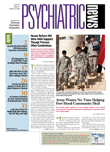The presence of psychotic symptoms is a significant risk factor for mortality in patients with depression who attempt suicide, according to an analysis of suicide attempters in Finland.
A group of Finnish researchers, led by Kirsi Suominen, M.D., Ph.D., of the Department of Mental Health and Substance Use in Finland's National Institute of Health and Welfare, analyzed the health records of all individuals who were hospitalized for a suicide attempt along with a diagnosis of major depressive disorder from 1996 to 2003 in Finland.
After hospitalization for the suicide attempt, nearly one-third (31 percent) of the attempters made at least one subsequent suicide attempt within the follow-up period, which averaged 4.2 years. Six percent of the 1,820 patients eventually died of suicide during the study's time frame. Two percent died of nonnatural causes other than suicide, and 5 percent died of other causes. In total, 233 patients (13 percent) died of any cause.
The rate of suicide death increased in the first two years after the recorded attempt and then reached a plateau. However, the cumulative rate of suicide attempts continued to rise over time.
Compared with patients who have depression without psychotic features, those who were diagnosed with psychotic features during the initial hospitalization had a significantly elevated risk for subsequent suicide death (hazard ratio [HR] 3.32, 95 percent confidence interval [CI] 1.95 to 5.67). Patients with depression plus psychotic features also had significantly elevated all-cause mortality (HR 2.00, 95 percent CI 1.30 to 3.07).
Psychotic features were not, however, associated with significant differences in the risk for subsequent suicide attempts. The reason for this finding may be that patients with psychotic features were more likely to die and cease to contribute to the cumulative rate of attempts, the authors explained.
Other significant risk factors for suicide mortality included being male and aged from 51 to 60.
Predictors of subsequent nonfatal suicide attempts demonstrated a somewhat different pattern from that found for predictors of mortality. Men and women had similar rates for subsequent attempts, and age was not a significant predictive factor. Rather, receiving treatment with antipsychotic or antidepressant drugs in the first two weeks after the initial hospitalization was associated with elevated risk of future attempts, which may be a reflection of higher disease severity, the researchers suggested.
They also concluded that receiving antidepressant treatment in the first two weeks after the initial hospitalization was associated with significantly lower all-cause mortality but showed no association with suicide mortality risk during the follow-up period.
The study was funded by the Jalmari and Rauha Ahokas Foundation and published in the October Journal of Clinical Psychiatry. According to the most recent World Health Organization data, the annual suicide mortality rate in Finland was 18.8 per 100,000 in 2007, higher than the worldwide average of 16 per 100,000 annually.
